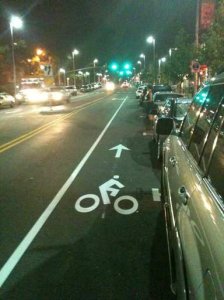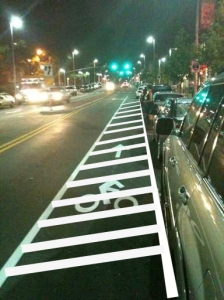The city of Raleigh, NC reconfigured Hillsborough Street to include a raised median and a single lane of traffic in each direction. But in July 2011 the city installed perhaps the worst Door Zone Bike Lanes (DZBLs) in the country.
What it was before.
What it was going to be.
What it was going to be #2.
What it became.
The City of Raleigh simply re-labeled buffers as bike lanes.
They didn’t do it out of mere ignorance of the hazards or standards, already an unforgivable excuse. The city administrators and staff willfully ignored the dangers and published guidelines. I gave them this paper in August 2010 condemning the then proposed bike lane design.
Bicyclists who are bike lane advocates pushed for the bike lane, and the City of Raleigh and NCDOT caved to their pressure.
Vulnerable, exposed bicyclists are forced to operate in what was the buffer, risking collision with suddenly opening doors, while motorists surrounded by steel frames and air bags enjoy the protection afforded by the bike lane buffer. Can you see the female pedestrian in black attempting to cross right to left?





August 2, 2011 at 7:43 am
Wayne, thank you for documenting this and leaving a paper trail.
August 9, 2011 at 12:30 pm
Only injuries and/or lawsuits will stop bad design.
Good luck.
August 9, 2011 at 3:28 pm
Apparently injuries haven’t worked too well in stopping DZBLs. I don’t know if any lawsuits have been filed or how they may have fared.
February 2, 2012 at 11:51 pm
[…] between cyclist and city leaders, legislation is starting to be created that will create bicycle specific lanes on city streets. The early effects of this can already be witnessed on Hillsborough Street in […]
February 21, 2012 at 11:31 am
[…] been tested and proven before implementation. A great example of bad design can be seen here in the discussion by Wayne Pein (thanks Wayne) – you have to ask, who had it in for the […]
March 15, 2012 at 7:42 pm
If you google for “door zone United States fatality statistics”, there is little data which is itemized for this hazard.
Mostly, you see things like this:
The Door Prize: Cyclists killed by dooring:
http://bicyclesafe.com/doorprize.html
You will notice that this has very few deaths, and many of them are dated.
Despite the paucity of deaths and the venerableness of the data, this is given as evidence that one should avoid the door zone.
More googling (this all took < 5 minutes):
http://www.google.com/url?sa=t&rct=j&q=&esrc=s&source=web&cd=10&ved=0CHMQFjAJ&url=http%3A%2F%2Fnyc.gov%2Fhtml%2Fdot%2Fdownloads%2Fpdf%2Fbicyclefatalities.pdf&ei=74H6Ts7UN8b0sQKv5oC_AQ&usg=AFQjCNFFbYnqh05Qz1-6w5xTeryiiMxAMQ&sig2=Hnyp5OCBrjwOnUu33RaEBw
I found dooring to be 0.44% in New York and Orlando, 0%, both of which are not rural. NYC is WELL LIT as well.
Toronto has a 0.4% of deaths in 2003 from dooring while there are 4x as many deaths from being rear ended.
In the Ken Cross study, dooring was a mere 0.6% fatal vs. 24% by being rear ended.
Even with the statistical games that John Forester plays, which discounts situations where I find myself all the time, it’s 5% of
deaths are by rear ending which is 8x as high for being doored.
I’m just saying that whenever you give risk of the door zone, you need to list the number of fatalities in other areas such as the travel lane. Otherwise, the data is misleading.
For NYC bike lanes for example:
"Only one fatal crash with a motor vehicle occurred when a bicyclist was in a marked bicycle lane."
Thus, 99.6% of all bicycle accidents occured OUTSIDE of a bike lane.
Ride in a bike lane at your own risk. Ride OUTSIDE a bike lane at greater risk.
March 15, 2012 at 8:19 pm
Fred,
There is much wrong with your analysis, but I won’t take the time to convince you of that. I will give you a link to a video that everyone should watch at:
June 13, 2012 at 4:59 pm
So if I created a video of bicycles rear ended by cars, would that change your mind? It’s not what happens in an accident, but rather what actually causes serious injury in the real world.
I posted a ton of data, and you post a cartoon to refute it.
Also, if motorists are expected to act lawfully, it’s unlawful to open a door without looking.
So it’s equally illegal to door someone as it is to rear end them.
However, it’s more likely to kill someone if they get rear ended.
Finally, I did not do any analysis at all but merely posted the results of census quality (the highest quality) data from cities.
Please post some data next time.
June 13, 2012 at 7:36 pm
I would love to see a video of rear end collisions on a road like Hillsborough.
Your data makes the mistake of relying only on fatals.
You are free to operate in the Door Zone or however you like. But don’t say you haven’t been warned.
July 31, 2013 at 10:05 am
Focusing on fatality statistics alone under-represents the hazards car doors pose to cyclists. In 2003 in Toronto, door collisions accounted for 12% of car-bike accidents. In Chicago in 2011, doorings accounted for 20% of bike crashes. (http://en.wikipedia.org/wiki/Door_zone). Note that these statistics do not include additional accidents that occur in the travel lane when cyclists instinctively enter the lane to avoid a collision with a car door.
In my state (Idaho) the law says I must ride as close to the right as is “praticable” but grants exceptions to avoid hazards. As far as I’m concerned If there are cars parked along the curb, “practicable” means I get to take the center of the travel lane for my own safety, and I’d be happy to argue such before a judge.
July 31, 2013 at 5:46 pm
I’m with you Dave. Thanks for reading and replying.